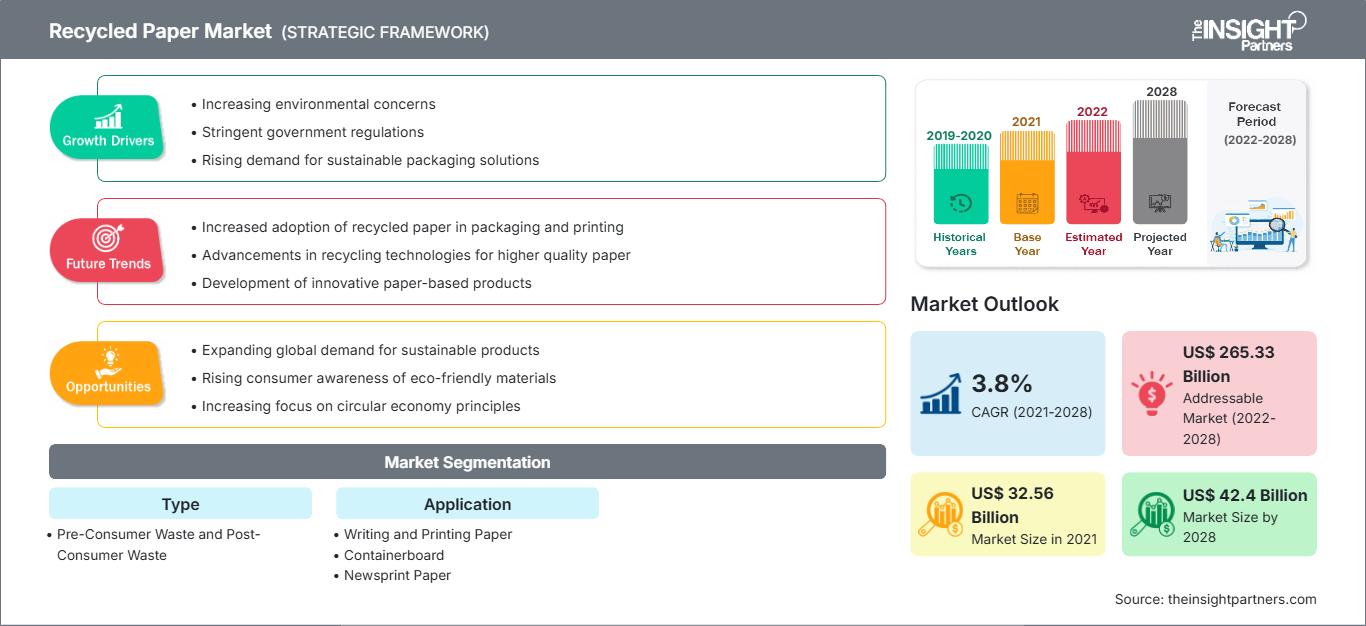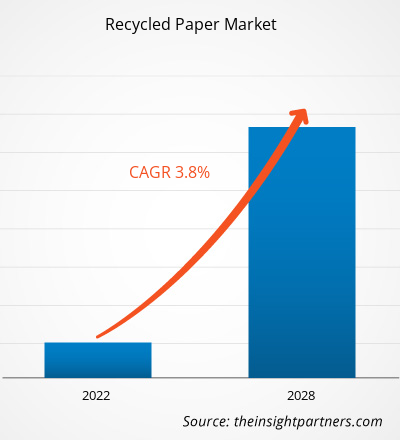재활용지 시장은 2021년 325억 5,844만 달러에서 2028년 423억 9,579만 달러로 성장할 것으로 예상되며, 2021년부터 2028년까지 연평균 성장률(CAGR) 3.8%로 성장할 것으로 예상됩니다.
다양한 국가 정부의 폐지 재활용 장려 정책 확대로 인해 재활용지 수요가 크게 증가하고 있습니다. 재활용지는 산업용으로 사용되는 종이에 국한되지만, 신문, 잡지, 포장지와 같은 가정용 폐지도 포함됩니다. 이러한 폐지 발생량은 매우 많으므로, 매립하거나 소각하는 대신 재활용해야 합니다. 정부 규제 시행 및 재활용지 관련 새로운 협회 설립으로 인해 향후 재활용지 시장은 빠르게 성장할 것으로 예상됩니다.
아시아 태평양 지역의 재활용지 시장은 예측 기간 동안 가장 높은 연평균 성장률(CAGR)로 성장할 것으로 예상됩니다. 호주, 중국, 인도, 일본을 포함한 많은 아시아 태평양 국가에는 철강, 광업 및 야금, 석유화학, 석유 및 가스, 식음료, 섬유와 같은 많은 제조 산업이 있습니다. 급속한 경제 성장과 도시화로 인해 폐기물 발생 및 관리가 아시아에서 주요 사회적, 환경적 문제가 되고 있습니다. 아시아의 모든 국가는 고형 폐기물 관리 및 재료 순환 정책에 대한 구체적인 조치를 가지고 있습니다. 매립은 비용이 저렴하기 때문에 많은 아시아 국가에서 채택한 가장 일반적인 처리 옵션입니다. 이 지역의 많은 국가가 최근 도시 고형 폐기물(MSW)에 대한 법률을 도입했습니다. 세계은행에 따르면 APAC의 도시 지역은 하루에 약 760,000톤의 MSW를 생산하며 이 수치는 2025년까지 180만 톤으로 증가할 것으로 추산됩니다. 아시아 태평양의 다양한 산업에서 흰색 및 모든 컬러 종이, 판지, 신문, 잡지 및 브로셔, 분쇄된 종이, 인쇄 문서와 같은 제품에 대한 잠재적 수요가 증가하고 있습니다. 따라서 아시아 태평양 지역에서 재활용지에 대한 수요가 급증하고 있으며, 시장 성장도 촉진되고 있습니다.
이 보고서의 일부, 국가 수준 분석, Excel 데이터 팩을 포함하여 모든 보고서에 대한 사용자 정의를 무료로 받을 수 있을 뿐만 아니라 스타트업 및 대학을 위한 훌륭한 제안 및 할인을 이용할 수 있습니다
재활용지 시장: 전략적 통찰력

- 이 보고서의 주요 주요 시장 동향을 확인하세요.이 무료 샘플에는 시장 동향부터 추정 및 예측에 이르기까지 데이터 분석이 포함됩니다.
COVID-19 팬데믹이 재활용지 시장에 미치는 영향
COVID-19 팬데믹은 화학 및 소재 산업의 상황을 크게 변화시켰고 재활용지 시장 성장에 부정적인 영향을 미쳤습니다. 바이러스 확산을 막기 위한 조치 시행은 상황을 악화시켰고 여러 산업 분야의 성장에 영향을 미쳤습니다. 이러한 급격한 변화는 자동차 및 포장 산업과 같은 산업의 운영 효율성과 국가 및 국제 경계의 갑작스러운 폐쇄로 인한 가치 사슬의 차질에 영향을 미쳤습니다. 여러 산업 분야의 성장이 크게 둔화되면서 글로벌 시장의 재활용지 수요에 상당한 영향을 미쳤습니다. COVID-19 팬데믹으로 인해 전 세계 공장 폐쇄로 인해 시장은 생산에 부정적인 영향을 미쳤습니다. 이번 팬데믹은 재활용지 시장에 적정 수준의 영향을 미칠 것으로 예상되며, 향후 2~3분기 안에 시장이 회복될 것으로 예상됩니다.
시장 분석
폐기물 관리에 대한 엄격한 정부 규제
폐기물 축적과 관리 실패가 환경에 미치는 영향에 대한 인식이 높아지면서 전 세계 각국 정부가 폐기물 관리 관련 규제를 시행하는 주요 원인이 되었습니다. 미국, 캐나다, 인도, 중국, 일본, 독일 등 여러 국가에서 종이 재활용 산업이 확대되고 있습니다. 각국 정부는 폐지 재활용을 장려하기 위한 규제를 시행하고 있습니다. 미국산림제지협회(AF&PA), 독립폐지가공업협회(IWPPA), 제지산업연합(CPI), 유럽폐지협회(ERPA) 등 여러 협회가 폐지 재활용을 장려하고 있습니다. 이러한 협회들은 재활용지 시장의 성장을 뒷받침하고 있습니다.
유형별 인사이트
재활용지 시장은 종류에 따라 소비 전 폐기물(pre-consumer waste)과 소비 후 폐기물(post-consumer waste)로 구분됩니다. 소비 전 폐기물 부문은 2020년에 더 큰 시장 점유율을 차지했으며, 예측 기간 동안 더 빠른 성장세를 보일 것으로 예상됩니다. 소비 전 재활용은 제품 제조 또는 유통 과정에서 발생하는 폐기물을 소비자에게 전달되기 전에 회수하는 것입니다. 소비 전 재활용 재료는 분해되어 유사하거나 다른 재료로 재생산될 수 있습니다. 종이의 경우, 소비 전 폐기물은 절단 과정에서 절단되어 버려지는 자투리와 잔여물을 의미합니다. 따라서 소비 전 폐기물 부문은 향후 몇 년 동안 잠재적인 성장 기회를 가질 것으로 예상됩니다.
응용 분야 인사이트
재활용지 시장은 용도에 따라 필기 및 인쇄용지, 골판지, 신문지, 티슈 등으로 구분됩니다. 컨테이너보드 부문은 매년 1억 톤 이상 생산되는 최대 생산량으로 성장할 것으로 예상됩니다. 인쇄 및 필기용지 부문의 성장은 사무실, 가정, 학교 및 정부 기관 등 다양한 분야에서 널리 사용되고 있기 때문입니다. 신문지 부문 또한 신문 및 기타 출판물 인쇄에 사용됨에 따라 시장 점유율이 확대될 것으로 예상됩니다. 재활용지 시장의 주요 기업으로는 Cascades Recovery+, Global Waste Recyclers Ltd, Hanna Paper, Heinzel Holding GmbH, Republic Services, Inc., International Paper, Perlen Papier, Sonoco Products Company, ST PAPER RESOURCES PTE LTD, WASCO 등이 있습니다. 주요 기업들은 인수합병 및 연구 개발과 같은 전략을 통해 고객 기반을 확대하고 글로벌 시장에서 상당한 점유율을 확보하여 전 세계적으로 브랜드 인지도를 유지하고 있습니다.
재활용지 시장
The Insight Partners의 분석가들은 예측 기간 동안 재활용지 시장에 영향을 미치는 지역별 동향과 요인을 면밀히 분석했습니다. 이 섹션에서는 북미, 유럽, 아시아 태평양, 중동 및 아프리카, 그리고 중남미 지역의 재활용지 시장 부문과 지역별 분포도 살펴봅니다.
재활용지 시장 보고서 범위
| 보고서 속성 | 세부 |
|---|---|
| 시장 규모 2021 | US$ 32.56 Billion |
| 시장규모별 2028 | US$ 42.4 Billion |
| 글로벌 CAGR (2021 - 2028) | 3.8% |
| 이전 데이터 | 2019-2020 |
| 예측 기간 | 2022-2028 |
| 다루는 세그먼트 |
By 유형
|
| 포함된 지역 및 국가 | 북미
|
| 시장 선도 기업 및 주요 회사 프로필 |
|
재활용지 시장 참여자 밀도: 비즈니스 역학에 미치는 영향 이해
재활용지 시장은 소비자 선호도 변화, 기술 발전, 그리고 제품의 장점에 대한 인식 제고 등의 요인으로 최종 사용자 수요가 증가함에 따라 빠르게 성장하고 있습니다. 수요가 증가함에 따라 기업들은 제품 라인업을 확장하고, 소비자 니즈를 충족하기 위한 혁신을 추진하며, 새로운 트렌드를 적극 활용하고 있으며, 이는 시장 성장을 더욱 가속화하고 있습니다.

- 을 얻으세요 재활용지 시장 주요 주요 플레이어 개요
보고서 스포트라이트
- 재활용지 시장의 진보적인 산업 동향은 플레이어가 효과적인 장기 전략을 개발하는 데 도움이 됩니다.
- 선진국과 개발도상국 시장에서 채택한 사업 성장 전략
- 2018년부터 2028년까지 재활용지 시장에 대한 정량적 분석
- 재활용지에 대한 글로벌 수요 추정
- 산업에서 활동하는 구매자와 공급업체의 효율성을 보여주기 위한 PEST 분석
- 경쟁적인 시장 시나리오를 이해하기 위한 최근 개발
- 시장 동향 및 전망과 재활용지 시장 성장을 주도하고 제한하는 요소
- 상업적 관심을 뒷받침하고 시장 성장을 이끄는 시장 전략을 강조하여 의사 결정 프로세스 지원
- 다양한 노드에서의 재활용지 시장 규모
- 시장의 자세한 개요 및 세분화와 재활용지 산업 역학
- 규모 다양한 지역의 재활용지 시장, 유망한 성장 기회
유형별 재활용지 시장
- 소비자 이전 폐기물
- 소비자 이후 폐기물
용도별 재활용지 시장
- 인쇄지
- 컨테이너보드
- 신문지
- 티슈
- 기타
회사 프로필
- Cascades Recovery+
- Global Waste Recyclers Ltd.
- Hanna Paper
- Heinzel Holding GmbH
- Republic Services, Inc.
- International Paper
- Perlen Papier
- Sonoco Products Company
- ST PAPER RESOURCES PTE LTD
- WASCO
- 과거 분석(2년), 기준 연도, CAGR을 포함한 예측(7년)
- PEST 및 SWOT 분석
- 시장 규모 가치/거래량 - 글로벌, 지역, 국가
- 산업 및 경쟁 환경
- Excel 데이터세트
최근 보고서
관련 보고서
사용 후기
구매 이유
- 정보에 기반한 의사 결정
- 시장 역학 이해
- 경쟁 분석
- 고객 인사이트
- 시장 예측
- 위험 완화
- 전략 기획
- 투자 타당성 분석
- 신흥 시장 파악
- 마케팅 전략 강화
- 운영 효율성 향상
- 규제 동향에 발맞춰 대응




















 무료 샘플 받기 - 재활용지 시장
무료 샘플 받기 - 재활용지 시장